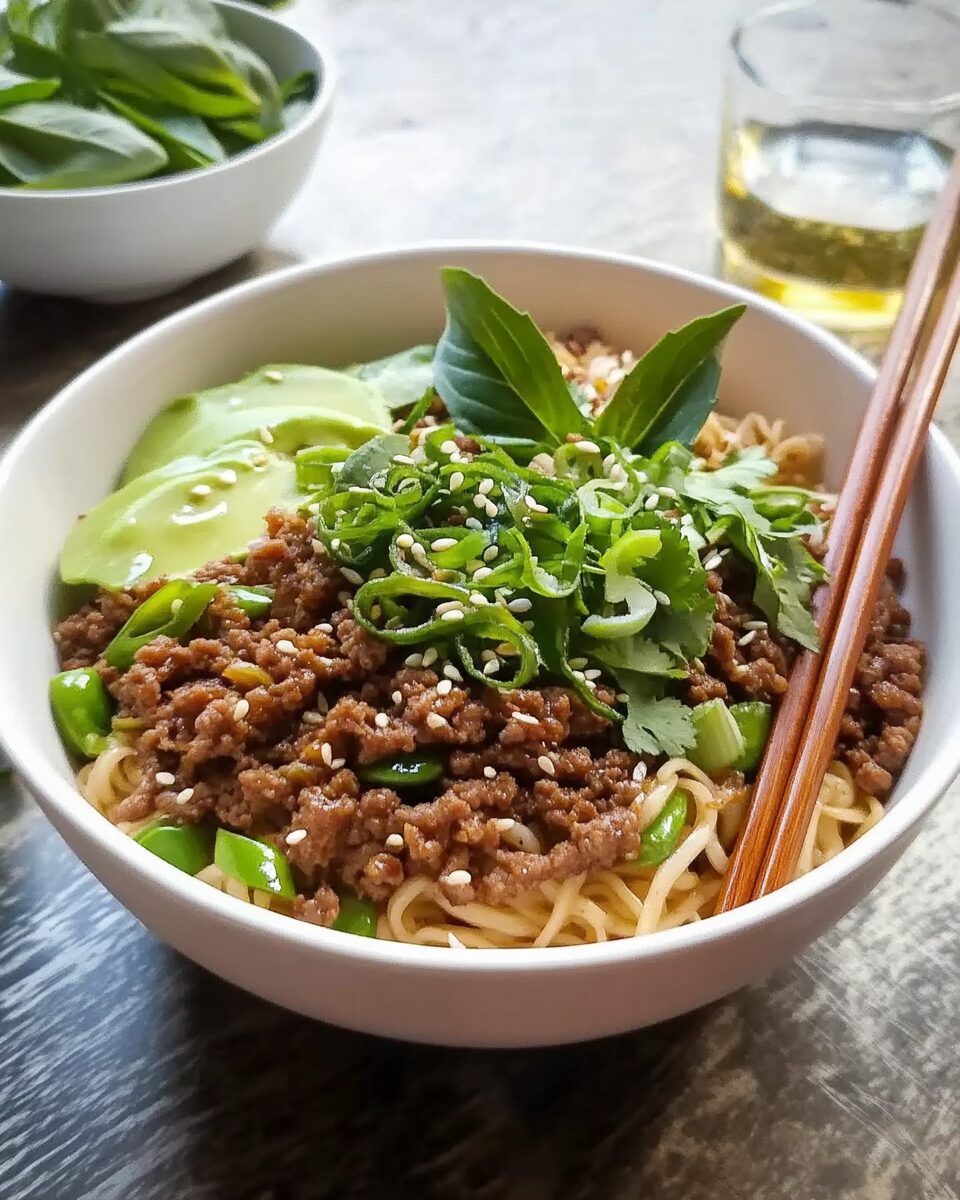Asian Ground Beef Noodle Bowls offer a perfect balance of savory, sweet, and tangy flavors, with tender noodles, flavorful ground beef, and fresh vegetables, all brought together with an irresistible sauce. This dish is a fantastic way to enjoy a satisfying, quick, and delicious meal, ideal for busy weeknights. It’s simple to prepare, customizable, and full of rich, umami-packed flavor. Whether you’re craving comfort food or a new go-to dish, these noodle bowls will quickly become a favorite in your recipe rotation.
Full Recipe:
Ingredients
- 1 lb ground beef
- 2 tablespoons sesame oil
- 1 tablespoon vegetable oil
- 3 cloves garlic, minced
- 1-inch piece of ginger, grated
- 1 tablespoon soy sauce
- 1 tablespoon hoisin sauce
- 1 tablespoon rice vinegar
- 1 tablespoon brown sugar
- 1 teaspoon chili paste (optional)
- 8 oz cooked noodles (such as ramen or rice noodles)
- 1/2 cup shredded carrots
- 1/2 cup sliced bell peppers
- 1/4 cup green onions, sliced
- 1 tablespoon sesame seeds for garnish
Directions
- Heat sesame oil and vegetable oil in a large skillet over medium heat. Add ground beef and cook until browned, breaking it apart with a spoon.
- Add garlic and grated ginger to the skillet, cooking for about 1 minute until fragrant.
- Stir in soy sauce, hoisin sauce, rice vinegar, brown sugar, and chili paste (if using). Simmer for about 2-3 minutes, allowing the sauce to thicken slightly.
- While the beef mixture simmers, cook your noodles according to package instructions and drain.
- Once the beef mixture is ready, toss it with the cooked noodles, carrots, and bell peppers. Stir until well combined.
- Serve the noodle bowls topped with sliced green onions and sesame seeds. Enjoy!
Nutrients
Serving size: 1 bowl
Calories: 450
Total fat: 22g
Saturated fat: 6g
Cholesterol: 50mg
Sodium: 850mg
Total carbohydrates: 40g
Dietary fiber: 4g
Sugars: 10g
Protein: 25g
The Origins of Asian Ground Beef Noodle Bowls
The concept of noodle bowls has been central to many Asian cuisines, particularly in countries like China, Japan, Thailand, and Vietnam. Noodles are often served with savory broths or stir-fried with vegetables and meats. While each country has its variation, the common thread across these dishes is the balance of flavors—salty, sweet, spicy, and sour. Asian Ground Beef Noodle Bowls borrow from these traditional elements, using ground beef as the protein base and combining it with fresh vegetables, noodles, and a sweet-savory sauce to create a harmonious meal.
The addition of ground beef in this dish brings a hearty element to what is often a vegetable-heavy noodle bowl, making it more filling and satisfying. Ground beef also absorbs the flavors of the sauce beautifully, providing a rich, savory bite with every spoonful. This recipe is a simplified version of more complex noodle bowl dishes that often involve marinated meats or multiple cooking steps, offering a quicker alternative that doesn’t sacrifice flavor.
Why Asian Ground Beef Noodle Bowls Are So Popular
One of the key reasons for the popularity of Asian Ground Beef Noodle Bowls is their versatility. This dish can be easily adapted to suit various preferences, making it a great option for a wide range of palates. The combination of noodles, ground beef, and vegetables provides a satisfying meal that can be made lighter or more indulgent depending on your choices of ingredients.
This dish is also quick and easy to prepare. Using ground beef instead of whole cuts of meat speeds up the cooking process, and with just a few ingredients and simple steps, the meal can be ready in under 30 minutes. This makes it an ideal weeknight dinner for those with limited time to cook but still craving something flavorful and wholesome.
The ability to customize the dish is another key appeal. Whether you prefer rice noodles, ramen, or udon, you can choose the type of noodle that best suits your taste. The sauce can also be adjusted for sweetness, spice, and saltiness, allowing you to create a version of the dish that fits your personal preferences. And, of course, the addition of vegetables like bell peppers, carrots, and green onions adds crunch and freshness, making the dish even more balanced.
Nutritional Benefits of Asian Ground Beef Noodle Bowls
When it comes to a hearty, comforting meal like Asian Ground Beef Noodle Bowls, you may wonder if it’s a healthy option. Fortunately, this dish offers a great combination of nutritional benefits, especially when made with lean ground beef and plenty of fresh vegetables.
Protein: Ground beef is an excellent source of high-quality protein, which is essential for muscle repair, immune function, and overall health. Protein also helps keep you feeling full and satisfied, making this noodle bowl a great choice for a filling meal.
Iron: Beef is rich in heme iron, which is the most easily absorbed form of iron in the body. Iron is crucial for transporting oxygen throughout the body, and it plays a key role in maintaining energy levels. For those who don’t eat a lot of red meat, this dish can be a great source of iron.
Vitamins and Minerals: The vegetables in the dish, including bell peppers, carrots, and green onions, provide a variety of vitamins and minerals. Bell peppers are rich in vitamin C, which helps support the immune system and improve skin health. Carrots are an excellent source of vitamin A, which is vital for eye health, and green onions provide a boost of vitamin K and antioxidants.
Healthy Fats: Sesame oil, used in the sauce, contains healthy unsaturated fats that can support heart health. While it’s used in small quantities, sesame oil adds a nutty flavor and a boost of beneficial fats to the dish.
Customizable for Healthier Options: This dish can be made even healthier with a few modifications. For example, using whole wheat noodles or opting for a low-sodium soy sauce can reduce the carbohydrate content and sodium levels. If you’re looking to make the dish lighter, you can replace the ground beef with leaner proteins like ground turkey or chicken, or even tofu for a vegetarian version.
How to Customize Asian Ground Beef Noodle Bowls
One of the most appealing aspects of this dish is its versatility. Here are some ways you can customize your Asian Ground Beef Noodle Bowls to suit your tastes or dietary preferences:
-
Different Noodles: While the recipe calls for regular noodles like ramen or rice noodles, you can easily switch this out for your favorite type. Udon noodles or soba noodles are both great options that bring different textures to the dish. For a gluten-free option, use rice noodles or even spiralized zucchini for a low-carb alternative.
-
Make it Spicy: If you love heat, increase the amount of chili paste or add fresh chili peppers to the beef mixture. You can also drizzle some sriracha over the finished bowl for extra spice.
-
Vegetarian Version: For a plant-based alternative, swap out the ground beef for tofu, tempeh, or a meatless ground product. Tofu crumbles can absorb the savory sauce and provide a great texture in place of the beef. If you prefer vegetables as the main filling, consider adding mushrooms, bok choy, or spinach to increase the nutritional value.
-
Extra Crunch: If you love texture, consider adding more crunchy toppings. Roasted peanuts, toasted sesame seeds, or crispy fried onions would all complement the soft noodles and savory beef. For extra freshness, a sprinkle of fresh cilantro or mint on top can add a burst of flavor.
-
Make it Low-Carb: For a low-carb version, you can replace the noodles with cauliflower rice or shirataki noodles. These alternatives provide the same texture without the carbs, making the dish suitable for those following a low-carb or ketogenic diet.
-
Add More Vegetables: To boost the nutritional content, consider adding extra vegetables to the dish. Snow peas, bok choy, cabbage, or baby corn can all be quickly stir-fried and added to the noodle bowl. This will not only increase the fiber content but also add more color and variety to the dish.
What to Serve with Asian Ground Beef Noodle Bowls
While the Asian Ground Beef Noodle Bowl is a filling meal on its own, you can always add some complementary sides to enhance the experience:
-
Asian-Inspired Soup: A light miso soup or hot and sour soup would make a great appetizer before the noodle bowl. These soups add a warming element to the meal and further incorporate the flavors of Asian cuisine.
-
Spring Rolls or Dumplings: For a more substantial meal, consider pairing the noodle bowls with crispy spring rolls or steamed dumplings. These appetizers are easy to prepare and will complement the savory, saucy noodles.
-
Pickled Vegetables: A side of pickled vegetables, such as pickled cucumbers or kimchi, can provide a tangy contrast to the richness of the noodles and beef. The acidity helps balance the dish and adds a refreshing component to the meal.
-
Steamed Rice or Cauliflower Rice: If you prefer a rice-based side, steamed jasmine or basmati rice works well with these noodle bowls. For a lower-carb option, cauliflower rice can be used to complement the noodles without adding additional carbohydrates.
Meal Prep and Leftovers
Asian Ground Beef Noodle Bowls are an excellent option for meal prepping. You can prepare the beef mixture in advance and store it in the refrigerator for up to 3 days. The noodles can be kept separately, and when you’re ready to eat, simply reheat the beef mixture and toss it with the noodles. This makes it easy to have a satisfying meal on hand for busy days.
The dish also makes great leftovers, as the flavors tend to deepen over time. However, if you’re planning to store the noodles for later, it’s best to keep the noodles and beef mixture in separate containers to prevent the noodles from becoming soggy.
Conclusion: Why You Should Try Asian Ground Beef Noodle Bowls
In conclusion, Asian Ground Beef Noodle Bowls are a fantastic, versatile, and easy-to-make meal that combines rich flavors, satisfying textures, and healthy ingredients. Whether you’re looking for a quick weeknight dinner or a meal to impress your guests, this dish checks all the boxes. The ability to customize the recipe to your taste—whether that means adjusting the spice level, swapping proteins, or adding extra vegetables—makes it a go-to option for nearly any dietary preference or occasion.






